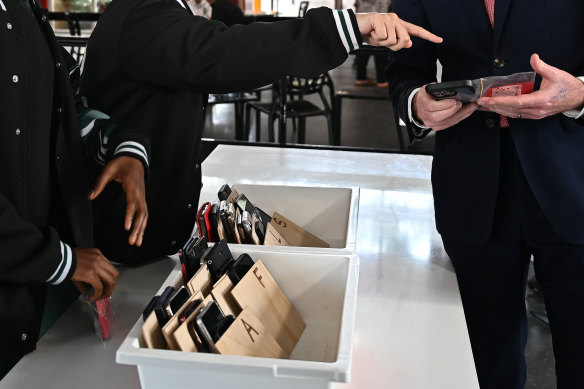Queensland to ban phones and smartwatches in state schools from 2024
By Matt Dennien
Queensland will join all other states and territories banning mobile phones in state schools, with the devices and smartwatches to be off-limits between the first and last bells – including breaks – from term one next year.
Education Minister Grace Grace made the announcement on Thursday night after what she described as a national commitment made at a meeting of interstate counterparts earlier in the day.

Students will still be able to bring phones to contact parents or carers “immediately before or after schools hours”, with some exceptions.Credit: AAP
After recent resistance to the idea, and contradictory advice, the state government loosened its opposition in April. Premier Annastacia Palaszczuk at the time said Queensland would “step up to the plate” if the federal government could arrange a national approach.
Principals across the state already use the power to restrict phone usage, but the issue reemerged after an election promise from the new NSW Labor government to ban the devices in high schools.
In a statement, Grace said 95 per cent of schools already had clear policies banning the use of phones during class times with all but 15 per cent of those bans also extending to break times.
“This statewide ban will provide uniformity, extend bans to break times, and include certain wearable devices like smartwatches,” she said.
“As has been the case for many years, principals who want to introduce or update bans before next year can do so.”
Students will still be able to bring phones to contact parents or carers “immediately before or after schools hours”, the media release published late on Thursday said. Exemptions would be available for digital learning or health and well-being related circumstances.
The state government appointed former Queensland Family and Child Commissioner Cheryl Vardon to review the current policy earlier this year.
While the report is not due until later this month, Grace said she had advised here that a “core recommendation” was the statewide restrictions.
Vardon’s full report would be used by the Education Department to work closely with schools on how to best implement a ban: from phones handed to a staff member at smaller schools to lockable pouches at a “school with thousands” of students.
“We are always happy to take a fresh look at things: the progression of technology and proliferation of wearable electronic devices meant it was time to do a review, and I thank Ms Vardon for her ongoing work,” Grace said.
Discussions were said to be continuing on consistent guidelines across states and territories.
Some researchers have argued the answers are not as simple as bans, with issues around how to enforce them, students needing to learn how to function with digital distractions, and bullying existing beyond the classroom online and offline.
The little research done into the worldwide trend has raised questions about the benefits, with one 2020 Swedish study finding high school student grades did not change after a ban.